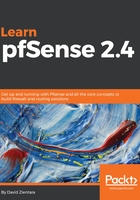
What this book covers
Chapter 1, Getting Started with pfSense, discusses about a brief history of the pfSense project and the role it can play in a network and in the pfSense community
Chapter 2, Installing pfSense, discusses the role a pfSense router/firewall plays in a typical network considering the different deployment scenarios. The initial process is covered from the initial installion from either CD or USB memstick through the completion of the web GUI setup wizard
Chapter 3, Configuring pfSense, takes us through advanced options such as customizing the web GUI, SSH login, configuring additional interfaces, and IPv6 configuration along with how to back up, restore and update your pfSense system
Chapter 4, Captive Portal, describes how to set up a captive portal in pfSense, how to leverage the numerous options available, and how to implement different authentication options and how to use vouchers
Chapter 5, Additional pfSense Services, takes through services such as DNS, Dynamic DNS, NTP, and SNMP in detail along with their examples
Chapter 6, Firewall and NAT, covers using firewall rules to block and allow traffic, and how to use scheduling and aliases to make the process easier.
Chapter 7, Traffic Shaping, covers how to use traffic shaping, including traffic shaping using the wizard and manual configuration, as well as how to configure floating rules for traffic shaping, as well as options for deep packet inspection
Chapter 8, Virtual Private Networks, includes when and how to use virtual private networks (VPNs) to provide an encrypted tunnel. L2TP, IPsec and OpenVPN protocols are discussed, as well as how to set up both a peer-to-peer and client-server tunnel
Chapter 9, Multiple WANs, covers common scenarios for using multiple WANs, such as bandwidth aggregation and failover, and how to set up gateways and gateway groups in pfSense
Chapter 10, Routing and Bridging, discusses what routing and bridging are, when it is possible or necessary to employ them, as well as how to perform static and dynamic routing in pfSense
Chapter 11, Diagnostics and Troubleshooting, deals with what to do when pfSense does not function as expected. A step-by-step process for solving and documenting problems is outlined, common problems are enumerated, different diagnostic tools are discussed, and example problems are presented